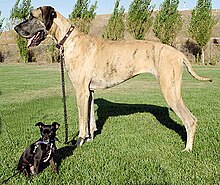| Revision as of 19:54, 27 January 2005 editMsh210 (talk | contribs)Autopatrolled, Extended confirmed users, Pending changes reviewers, Rollbackers4,853 editsm Stub-sorting. You can help!← Previous edit | Revision as of 01:12, 28 January 2005 edit undoElf (talk | contribs)Extended confirmed users19,731 editsm dog stubNext edit → | ||
| Line 16: | Line 16: | ||
| * | * | ||
| {{ |
{{dog-stub}} | ||
| ] | ] | ||
Revision as of 01:12, 28 January 2005

Dogs have been selectively bred for thousands of years. Initially the selections would have centred on domestication and useful qualities such as hunting ability. Later, dogs were also selected to give attractive and distinctive forms resulting in a vast variety of types. The point at which a new variety becomes a breed can be difficult to decide. National kennel clubs often differ in their recognition of breeds and rare breeds might not be recognised outside their home country. Usually, only dogs recognized by a kennel club are eligible to compete in the club's dog shows and dog sports.
Many traditional dog breeds recognised by the main registries are said to be "purebred". Only individuals whose parentage consists only of other purebred examples of the breed are regarded as part of that breed. This concept has caused controversy both because of the difficulty of regulation and because of the possible genetic consequences of a limited population.
Generally, before a type of dog is recognized as a breed, it must be shown that mating a pair of that type always produces dogs that have the same characteristics as the parents, usually both in appearance and in behavior. This is known as breeding true. There are many issues concerning what is considered breeding true. For example, Flat-Coated Retrievers must always be black; however, yellow coats occur occasionally in some litters. Kennel clubs do not recognize the yellow dogs as legitimate members of the breed; some breeders will euthanize the puppies rather than risk having the dog grow up, breed, and produce more of the undesired yellow color; more often, today, such dogs are neutered and placed in homes as pets. As another example, a breeding pair of Belgian Shepherds of the Groenendael variety can produce puppies of the Tervueren (brown) variety; the AKC considers the varieties to be different breeds and, therefore, the brown puppies are invalid and undesireable dogs, whereas the CKC considers them simply to be different varieties.
See Selective breeding for a detailed discussion on open versus closed studbooks and some of the issues concerning purebreds.
See also
External links
This dog-related article is a stub. You can help Misplaced Pages by expanding it. |